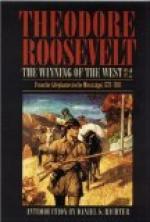He Starts against Vincennes.
On October 7th the expedition left Detroit; before starting the venerable Jesuit missionary gave the Catholic French who went along his solemn blessing and approval, conditionally upon their strictly keeping the oath they had taken to be loyal and obedient servants of the crown. [Footnote: Haldimand MSS., Series B., Vol. 123, p. 53. Hamilton’s letter of July 6, 1781, containing a “brief account” of the whole expedition, taken from what he calls a “diary of transactions” that he had preserved.] It is worthy of note that, while the priest at Kaskaskia proved so potent an ally of the Americans, the priest at Detroit was one of the staunchest supporters of the British. Hamilton started with thirty-six British regulars, under two lieutenants, forty-five Detroit volunteers (chiefly French), who had been carefully drilled for over a year, under Captain Lamothe; seventy-nine Detroit militia, under a major and two captains; and seventeen members of the Indian Department (including three captains and four lieutenants) who acted with the Indians. There were thus in all one hundred and seventy-seven whites. [Footnote: Do., Series B., Vol. 122, p. 253, return of forces on Dec. 24th.] Sixty Indians started with the troops from Detroit, but so many bands joined him on the route that when he reached Vincennes his entire force amounted to five hundred men. [Footnote: Do. Hamilton’s letter of July 6, 1781, the “brief account.” Clark’s estimate was very close to the truth; he gave Hamilton six hundred men, four hundred of them Indians. See State Department MSS., No. 71, Vol. I., p. 247. Papers Continental Congress. Letter of G. R. Clark to Gov. Henry, April 29, 1779. This letter was written seven months before that to Mason, and many years before the “Memoir,” so I have, where possible, followed it as being better authority than either.]
Difficulties of the Route.




